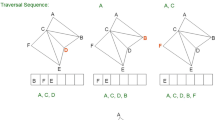Abstract
This paper proposes a cross recovery scheme to protect a group of 3D models. The lost or damaged models can be reconstructed using the mutual support of the survived authenticated models. In the encoding phase, we convert a group of n given models (called host models) into n stego* models. The n stego* models would still preserve the appearance of the n host models. In the decoding phase, we divide the received models into two groups: authenticated vs. non-authenticated. Then, we rebuild the recovered models of the non-authenticated group by the mutual support of any t authenticated models (t < n is a given parameter). The experimental results show that the visual quality of our stego* models is very similar to that of the host models, and the size of the stego* models is also very similar to that of the host models. Moreover, after hacker’s attack or disk crash, if the number of attacked or crashed stego* models is not larger than n − t, then the damaged or lost models can be recovered, and the recovered models still have acceptable quality. We also provide an equation which can estimate the suitable size of the recovered model in advance.







Similar content being viewed by others
References
Alregib G, Altunbasak Y, Rossignac J (2005) Error-resilient transmission of 3D models. ACM Trans Graph 24:182–208
Bischoff S, Kobbelt L (2002) Towards robust broadcasting of geometry data. Comput Graph 26:665–675
Blakley GR (1979) Safeguarding cryptographic keys. In: Proc. of the National Computer Conference, vol 48, pp 313–317
Bogomjakov A, Gotsman C, Isenburg M (2008) Distortion-free steganography for polygonal meshes. Comput Graph Forum 27:637–642
Cayre F, Macq B (2003) Data hiding on 3-D triangle meshes. IEEE Trans Signal Process 51:939–949
Chao MW, Lin CH, Yu CW, Lee TY (2009) A high capacity 3D steganography algorithm. IEEE Trans Vis Comput Graph 15:274–284
Chen X, Golovinskiy A, Funkhouser T (2009) A benchmark for 3D mesh segmentation. ACM Trans Graph 28:73
Cheng YM, Wang CM (2006) A high-capacity steganographic approach for 3D polygonal meshes. Vis Comput 22:845–855
Chou CM, Tseng DC (2007) Technologies for 3d model watermarking: A survey. Int J Comput Sci Netw Secur 7:328–334
Chung IL, Chou CM, Tseng DC (2011) Hiding data in triangle meshes by rearranging representation order. Int J Innov Comput Inf Control 7:3419–3435
Deng H, Chen L, Zhang J, Wang R (2012) A 3D model watermarking algorithm resistant to affine transformation. In: Proc. of the 4th International Conference on Multimedia Information Networking and Security, Nanjing, China, Nov 2-4, 2012, pp 549–551
Elsheh E, Ben Hamza A (2011) Secret sharing approaches for 3D object encryption. Expert Syst Appl 38:13906–13911
Hansen CD, Johnson CR (2005) The visualization handbook. Academic Press, Orlando
Lin CH, Chao MW, Chen JY, Yu CW, Hsu WY (2013) A high-capacity distortion-free information hiding algorithm for 3D polygon models. Int J Innov Comput Inf Control 9:1321–1335
Lin CK, Tan CI, Tai WK (2009) Vertex shuffling: a novel information hiding on 3D model. In: Proceedings of 2009 APSIPA Annual Summit and Conference, Sapporo, Japan, October 4-7, 2009, pp 178–185
Ohbuchi R, Mukaiyama A, Takahashi S (2002) A frequency-domain approach to watermarking 3D shapes. Comput Graph Forum 21:373–382
Ohbuchi R, Mukaiyama A, Takahashi S (2004) Watermarking a 3D shape model defined as a point set. In: Proc. of 2004 International Conference on Cyberworlds, Nov 18-20, 2004, pp 392–399
Peng J, Kim CS, Jay Kuo CC (2005) Technologies for 3D mesh compression: A survey. J Vis Commun Image Represent 16:688–733
Reed IS, Solomon G (1960) Polynomial codes over certain finite fields. J Soc Ind Appl Math 8:300–304
Rossignac J (1999) Edgebreaker: Connectivity compression for triangle meshes. IEEE Trans Vis Comput Graph 5:47–61
Thien CC, Lin JC (2002) Secret image sharing. Comput Graph 26:765–770
Tsai YY (2014) An adaptive steganographic algorithm for 3D polygonal models using vertex decimation. Multimed Tools Appl 69:859–876
Tu SC, Hsu HW, Tai WK (2010) Permutation steganography for polygonal meshes based on coding tree. Int J Virtual Real 9:55–60
Tu SC, Tai WK (2012) A high-capacity data-hiding approach for polygonal meshes using maximum expected level tree. Comput Graph 36:767–775
Wang CM, Cheng YM (2005) An efficient information hiding algorithm for polygon models. Comput Graph Forum 24:591–600
Wang RZ, Su CH (2006) Secret image sharing with smaller shadow images. Pattern Recognit Lett 27:551–555
Wicker SB, Bhargava VK (1999) Reed-Solomon codes and their applications. John Wiley and Sons, New York
Yu F, Lu Z, Luo H, Wang P (2011) Three-dimensional model analysis and processing. Springer and Zhejiang University Press
LZMA SDK. http://www.7-zip.org/sdk.html
MeshLab. http://meshlab.sourceforge.net/
Supplementary video. http://cs.nctu.edu.tw/sslee/supplement.wmv
Author information
Authors and Affiliations
Corresponding author
Rights and permissions
About this article
Cite this article
Lee, SS., Huang, YJ. & Lin, JC. Protection of 3D models using cross recovery. Multimed Tools Appl 76, 243–264 (2017). https://doi.org/10.1007/s11042-015-3032-4
Received:
Revised:
Accepted:
Published:
Issue Date:
DOI: https://doi.org/10.1007/s11042-015-3032-4




